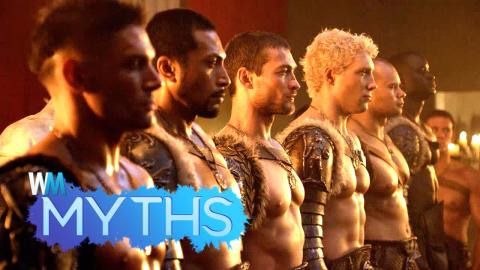Top 5 Myths About Gladiators

Yes, Maximus, we are entertained, but this video might change the perception. Welcome to WatchMojo's Top 5 Myths. In this instalment, we're dispelling myths about history's most fabled profession. Many of these misconceptions come from the movies, and while they often present a fairly accurate depiction of a gladiator's life, creative liberties are of course taken in the entertainment industry. With that out of the way, let the games begin as we count down the five most often-believed myths about gladiators.
Special thanks to our user christo for submitting the idea using our interactive suggestion tool at http://www.WatchMojo.comsuggest
#5: Thumbs down Meant Death
As shown in the movies, the Emperor in attendance chose whether the defeated gladiator would live or die using the thumbs up or thumbs down gesture. In reality, historians believe that though emperors did determine the fate of a gladiator using these gestures, their meanings are reversed: that thumbs down meant the gladiator would be spared, while thumbs up meant he would be slain in a Mortal Kombat-like finish. When an emperor was not in attendance—usually in battles outside the Colosseum—the crowd served as the reaper, as the volume of cheers determined the verdict. Historians surmise that other gestures were implemented perhaps more often than thumbs down, including a closed fist with two protruding fingers to signal mercy.
#4: There Were No Woman Gladiators
Because female gladiators are absent in most media portrayals, it is thought that women were not a part of the barbaric games. This is untrue, as women—both free and slaves—fought as legitimate gladiators. There were many fights featuring female combatants, and some were given larger roles in the events as they proved themselves as gifted fighters. A notable gladiatrix was Mevia, who was pitted against animals in incredibly entertaining bouts, and there is also an account of a long spectacular fight with two women, “Amazon” and “Achillia,” which ended in a draw. Being more of a novelty, women often fought handicapped opponents and competed in hunting challenges, but these spectacles ended around 200 AD after Emperor Severus banned them from the games—though some still fought illegally.
#3: Christians Were Thrown to the Lions in Gladiator Events
History has us believe that Christians were sacrificed in Gladiator events during the Roman Empire. While Christians were indeed executed as part of Roman rule, there are zero accounts of a Christian being thrown to the lions at the Colosseum, or being involved in any gladiatorial sacrifices. In fact, most Christian executions happened in the dawn of the Empire, and by the time gladiation became popular, Christians were free citizens. Also, animals were made mostly to fight each other, or to be slain in hunting competitions against inferior opponents, like Emperors who decided to participate. Some believe that this myth has been used as pro-Christian propaganda, in a way to accentuate the persecution that Christianity faced during its rise to power.
#2: Gladiators Were Always Slaves
This can also be seen in the movies. While a solid majority of people were forced into the profession through slavery, there were citizens—even Emperors themselves—who elected to fight through their own free will. This is becauseGladiators were the world’s first sports heroes. To be a gladiator was to get instant fame and glory. They were beloved, renowned, idolized: there were action figures, there were billboards, and the best of them even got sponsorships. They routinely filled the Colosseum that is estimated to have held as many as 80,000 spectators, along with 400 other arenas throughout the Empire. People even enrolled in gladiator schools, which were abundant in Rome, to the tune of 100 institutions. There were few others ways a plebeian could get noticed, let alone become a celebrity or sex symbol.
#1: Gladiators Always Fought to the Death
The best Gladiators were prized possessions that managers and promoters could not afford to lose. Therefore, not every fight was to the death. Referees were instated to stop major fights when a person got wounded, so as to allow the fighter the full milking of his worth. Of course, this safeguard was only installed for certain events, and the toll of the occupation severely weathered the fighters. It is estimated that 1 in 5 matches resulted in a death, and that most gladiators died by 25. The annual death count of Gladiators during the Roman reign was 5000. Multiply that by 700 years and you have 3.5 million deaths from just one sport… makes hockey seem tame, doesn’t it?
So, were these misconceptions cleared up? And does this change the way you view Gladiators? For more compelling top 10s and insightful Top 5s, be sure to subscribe to WatchMojo.com.
